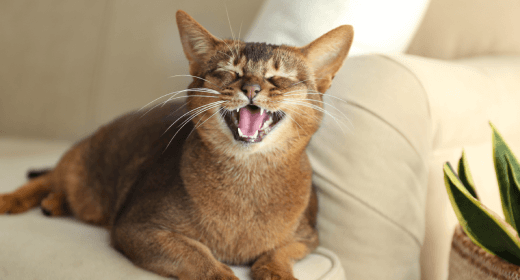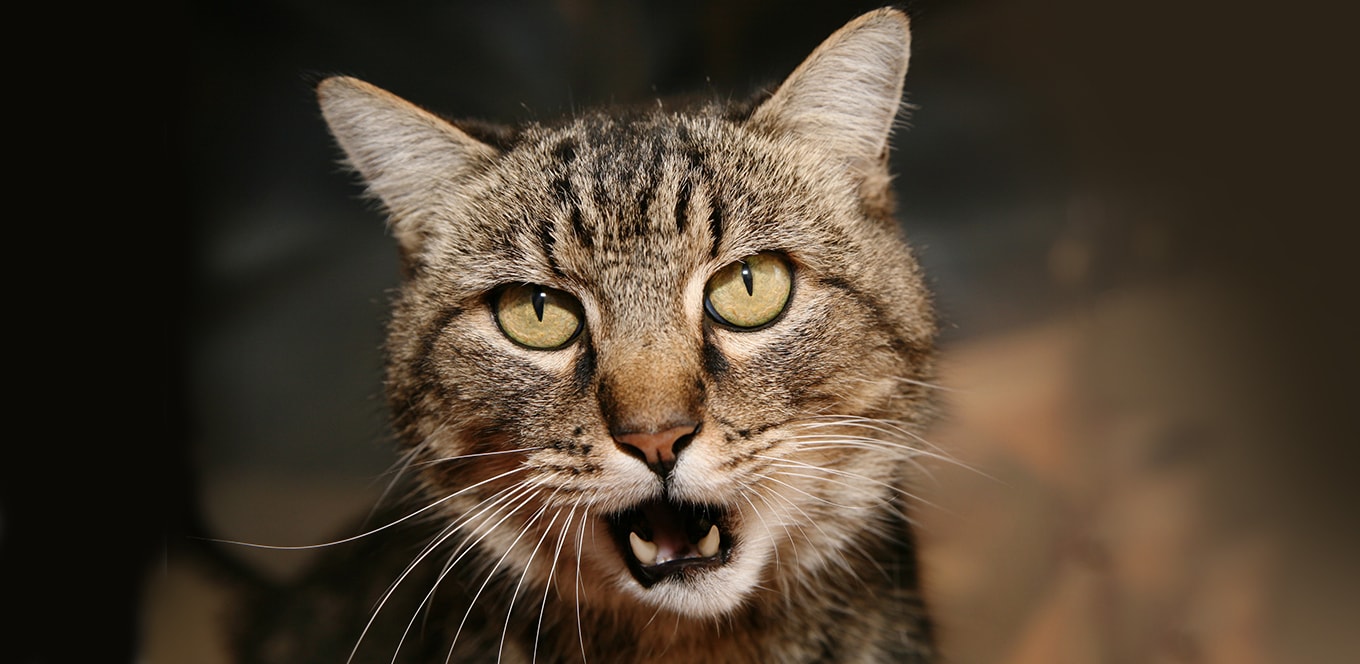

Listen up, Mom or Dad, because your feline definitely has something to say. Cats use more than 100 different vocal sounds to communicate. Here are nine of the most common sounds you’ll hear and what your cat’s unique language means.
While your cat’s purrs are usually a sign that they’re happy, comfortable or content, it’s important to point out that your cat might also purr when they are anxious, agitated or sick — because purring soothes them. The key to figuring out if it’s a “worry purr” is to check if their ears are folded back, if they seem tense or if they just aren’t acting normal. (If that’s the case, call the vet and grab the cat carrier.)
Why do cats meow? It’s simple: It’s their way of communicating with us!
Meows are your cat’s most common “word,” and every one means something different. For example, your cat might meow to greet you when you come home, to ask you to open your bedroom door so they can curl up on your pillow, or to say, “I’d like some more tasty kibble or a second serving of IAMS® PERFECT PORTIONS™ paté, s’il vous plaît.”
Chirps and trills are the loving language of cat mothers. Chirps, or chirrups, are staccato, bird-like sounds mother cats use to say to their kittens, “Follow me.” Trills are higher-pitched chirps your cat uses to say hello or “Pay attention to me.” When your cat directs these sounds at you, chances are they want you to give them some love or follow them somewhere, usually to their food or water bowl. (Shocker, LOL.)
If you have more than one feline fur baby, listen closely. You’ll likely hear your cats talk to each other with these sounds.
When your kitty spies an unsuspecting bird or squirrel frolicking outside the window, they might make a chattering sound at it. This distinctive, repetitive clicking noise is caused by a combination of lip smacking and your cat rapidly vibrating their lower jaw. This odd behavior looks like teeth chattering, and a lot of cats also chirp when they chatter.
This clickety sound is thought to be a mix of predatory excitement and frustration at not being able to get to the elusive feathered or furry prize. Some animal behaviorists even think the sound mimics a fatal bite used to break the bones of their prey. Who knew your li’l feline was so ferocious?!
Regardless of the exact reason cats chatter or chirp at birds and other small animals, most feline parents find it fascinating and amusing to watch.
The unmistakable sound of a cat hissing is like a steak hitting a hot skillet, and it can only mean one thing: Your cat feels threatened and will put up a fight if they have to. Just as important as the hissing sound, however, is the cat body language that comes with it. Your cat will flatten their ears, arch their back, puff their fur, twitch their tail and usually open their mouth to flash their fangs — aka the classic defensive pose.
In addition to a hiss, if your cat makes a deep, guttural growlsound, they’re saying, “Back off.” Similar to a dog’s growl, this noise means your cat is annoyed, scared or angry. Some cats even make short, higher-pitched snarl sounds before launching into a full-blown growl.
While these sounds usually signify an unhappy cat, it’s important to note that some cats growl because they’re in pain from an injury or a health problem. If you suspect this is the case, a trip to the vet is in order.
If your feline snarls or growls at you for any reason, though, it’s best to leave your feisty friend alone.
A yowl, or howl, is a long, drawn-out meow that almost sounds like moaning; it’s your cat’s way of telling you they’re worried or distressed, or that they need you. They might have gotten locked in a closet, can’t find you anywhere or, heaven forbid, have discovered their food bowl is empty. Your cat might also yowl when they don’t feel well or when a new neighborhood cat trespasses on their turf.
Whatever the reason, make sure you immediately help your cat whenever you hear a yowl. Trust us — you’ll both be glad you did.



Good nutrition is key to a long and healthy life for all living beings. That being said, cats need a balanced diet to be able to grow, maintain their body, stay active, and fight any illnesses or recover from them. As a pet parent, you must be aware of the right ingredients to include in your cat’s diet.
Cats are carnivores and they need nutrients that are found only in animal products. Cats were originally hunters and would feed on their prey to derive high amounts of protein, moderate amounts of fats, and some carbohydrates to maintain a nutritional diet. Today, most cats that are domesticated do not need to hunt but still require their food to contain the right proportions of nutrients to be able to live a healthy life. Apart from that, cats also need nutrients such as minerals, vitamins, fatty acids, and amino acids.
The best diet for cats will contain all the essential nutrients in the right proportions. A variety of ingredients can help you provide the right energy sources for your cat. For example, a nutrient like calcium can be derived from ingredients like dairy products, organ tissues, bones, bone meals, meat, legume plants, and through mineral supplements. Devising a cat diet plan is all about making sure your kitty gets the right amount of proteins, fats, carbohydrates, vitamins, minerals, and water. Keep reading to learn more about how different nutrients play a part in your cat’s well-being.
As carnivores, cats need to eat a lot more protein as compared to many other animals. Protein is also the primary source of energy in cats as it helps them maintain skin, hair, muscle, fur, tendons, ligaments, cartilage, enzymes, antibodies, hormones, and more. Cats use protein for energy and for maintaining their blood glucose levels. Its liver enzymes are continuously breaking down proteins to do so. If cats do not consume enough protein, their bodies will start breaking down their own muscles to fulfil their energy requirements.
The two main sources of protein used in cat food are plant protein and animal protein. If you are a vegetarian and a vegetarian diet appeals to you for your cat, keep in mind that this may not be the best decision for your feline’s well-being because it will not be able to meet its nutritional requirements through plant protein sources alone. Certain nutrients are only present in animal protein such as taurine, methionine, and cystine.
Animal protein in cat food is derived from chicken, turkey, lamb, beef, and fish. Different meat meals and meat by-products are also available in the market today. While many pet parents may think that these meals are not a good option, they actually act as a great source of concentrated protein.
The right amount of protein for cats depends on their age. Adult cats need a high percentage of protein as compared to dogs, humans, or many other animals. While the exact proportions may vary, adult cats need around 26% protein in their meals. Protein requirements for kittens may change according to their medical history and age. It is best to consult a veterinarian to make sure your kitten receives the right nutrition.
Vitamins are essential for your cat’s metabolic function and therefore must be included in small amounts in its diet. Many enzymes that help maintain normal feline metabolism cannot function without vitamins.
Several cat food ingredients such as fruits, vegetables, animal tissues, vegetable oils, grains, and seeds contain vitamins. It is very difficult to nail down the right amount of vitamins that your cat needs through just different foods. For this reason, vitamin supplements should be included in your cat’s diet.
If your cat is healthy and is eating a balanced and nutritious meal, additional vitamin supplements may not be necessary. In some cases, vitamin supplements can also be dangerous if your cat is already healthy and does not require them. It is best to consult a veterinarian and be sure of your cat’s health and its requirements.
Your cat’s body needs inorganic compounds, also known as minerals, to function properly. Many minerals that your cat needs are derived from animals and plant-based ingredients. However, for your cat’s food to be completely balanced, food manufacturers always add mineral protein to their food formulas.
There are a lot of minerals that should be present in your cat’s diet such as calcium, phosphorus, potassium, magnesium, iron, sodium, chloride, copper, zinc, manganese, iodine, and selenium. These minerals help cats maintain nerve, muscle, and heart function. They also aid in enzyme function, supplying oxygen throughout the body, skeletal growth, and much more. Your cat’s food formula will always contain some minerals. If you want to be sure about your kitten getting the right nutrition, take it to the vet and let them decide the perfect cat diet plan for your furry friend.
Crude fat is estimated by extracting fats that are present using ether and the crude fat level of every cat food formula will be listed in the guaranteed analysis section on the packaging label.
Including fats in your cat's diet is extremely important. While proteins are an important energy source for cats, fat is the most energy-rich nutrient in your cat's diet. They act as transport molecules that help carry out nerve impulses. Essential fat sources such as omega-3 fatty acids and omega-6 fatty acids help maintain your cat's skin, coat, and fur health.
Fats and other essential fatty acids are found in food formulas that contain liver, chicken, beef, turkey, and fish. At times, manufacturers add extra fat to their formula. You can ascertain the same by checking the fat sources on the ingredient list label. Fish oil, beef fat, and soybean oil are examples of added fat.
Keeping cat food weight management is extremely important when it comes to fats. Cats need to maintain a certain body type to stay active. Hence, a diet with high levels of fats is not recommended. Your feline friend should not be consuming more fat than it requires on a daily basis. Doing so will lead to your cat putting on weight and inviting health troubles. Talk to your veterinarian to know the ideal fat content for your cat’s diet.
Many animals need carbohydrates to obtain energy. However, since cats derive most of their energy from proteins and fats, carbohydrates are not that important in their diet. No, this does not mean that you can completely stop including carbs in your cat’s diet. Small amounts of carbohydrates are ideal for your cat to derive some energy. A diet that contains high levels of carbs is not recommended for cats at all since it may aid in putting on weight and will attract serious diseases such as diabetes.
Your cat’s diet should not include more than 10% of carbohydrates. Dry diets may have high amounts of carbohydrates. The only way to ensure that your cat is not eating too much carbs is by including wet food in its diet.
The best diet for cats includes the right balance of all nutrients. A perfect balance of proteins, fats, carbohydrates, vitamins, minerals, and water will help your cat to grow healthy and maintain its ideal body weight. If you are concerned about your cat’s diet and need more insights on what to feed your cat in what proportions, simply reach out to your local veterinarian.